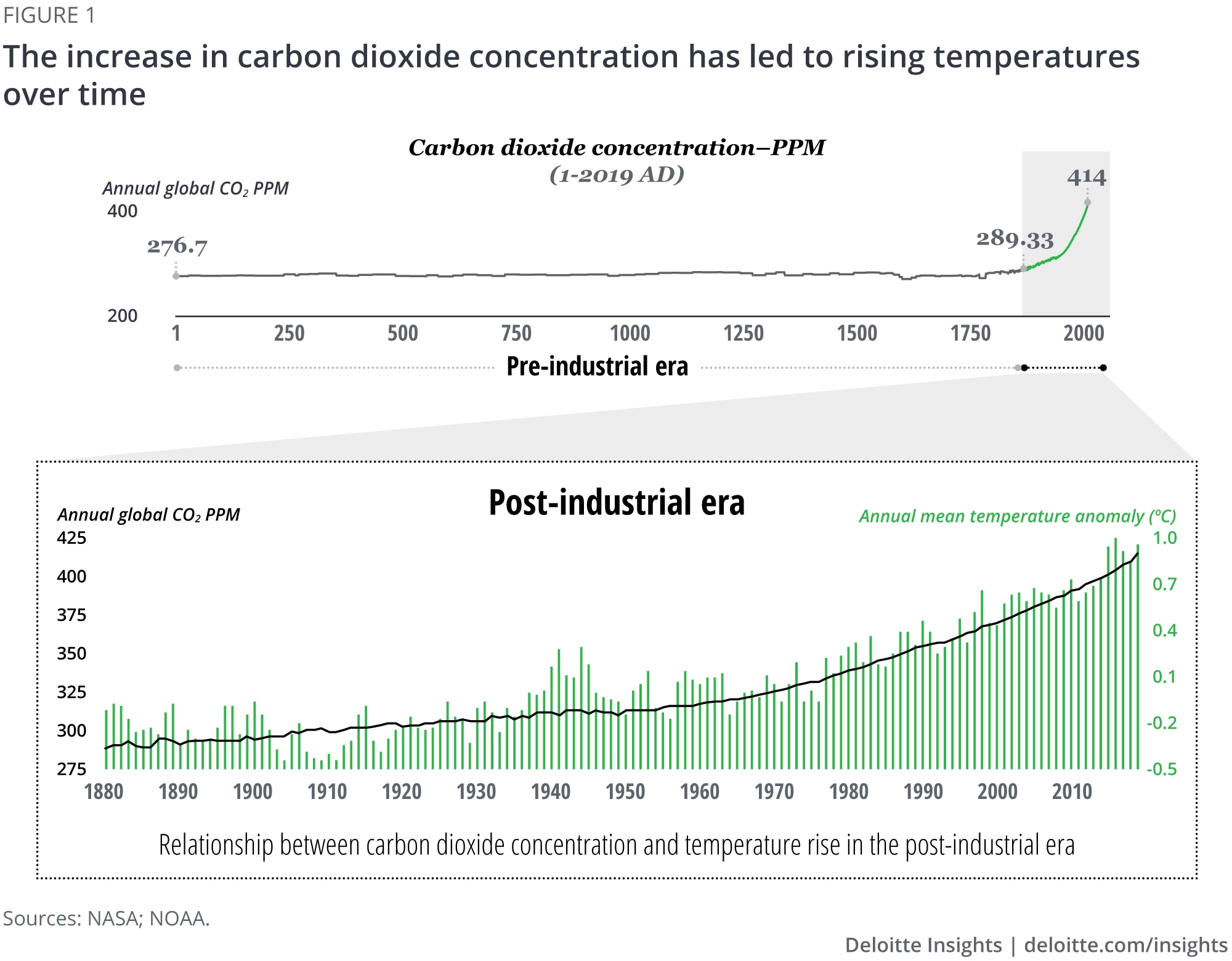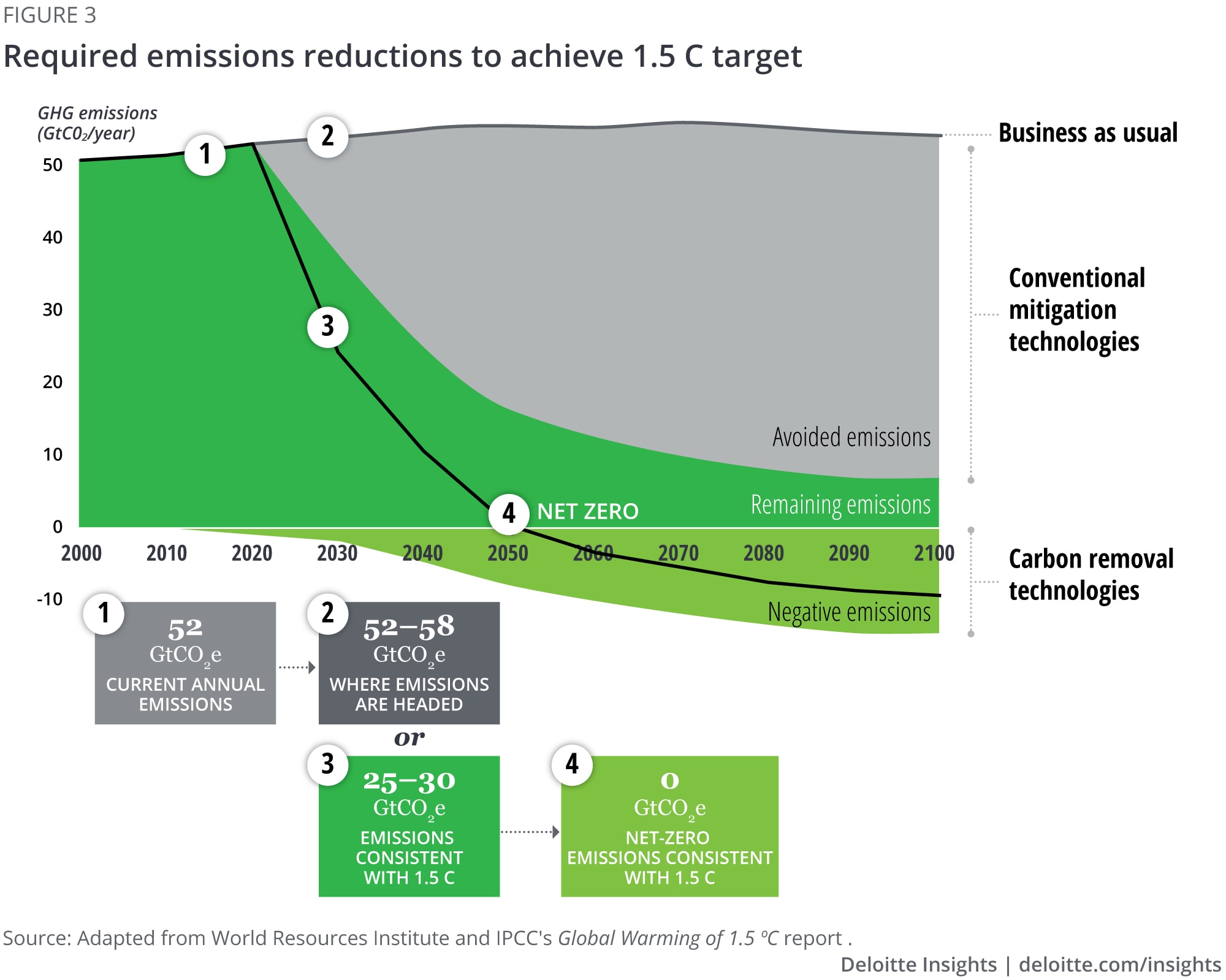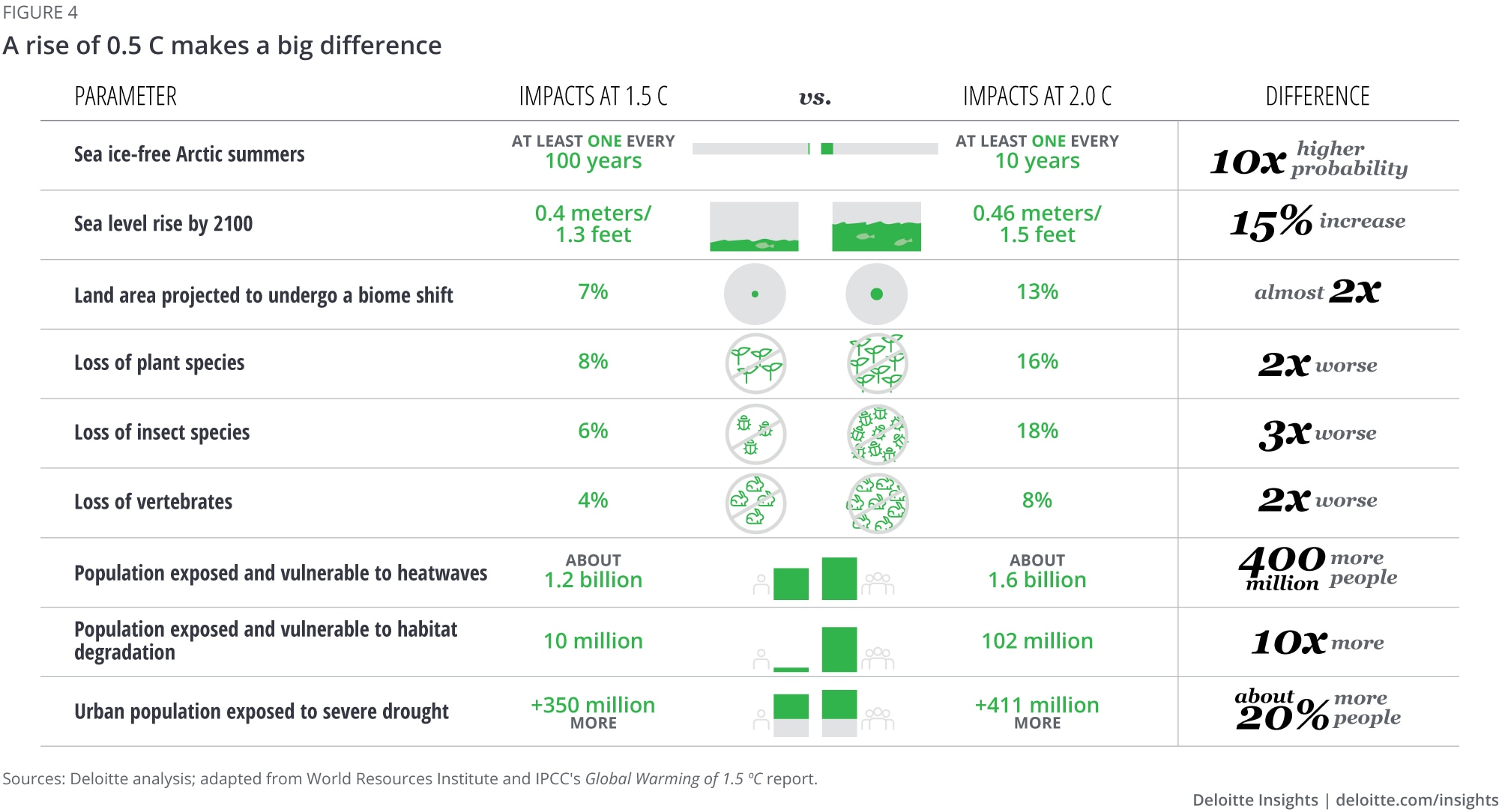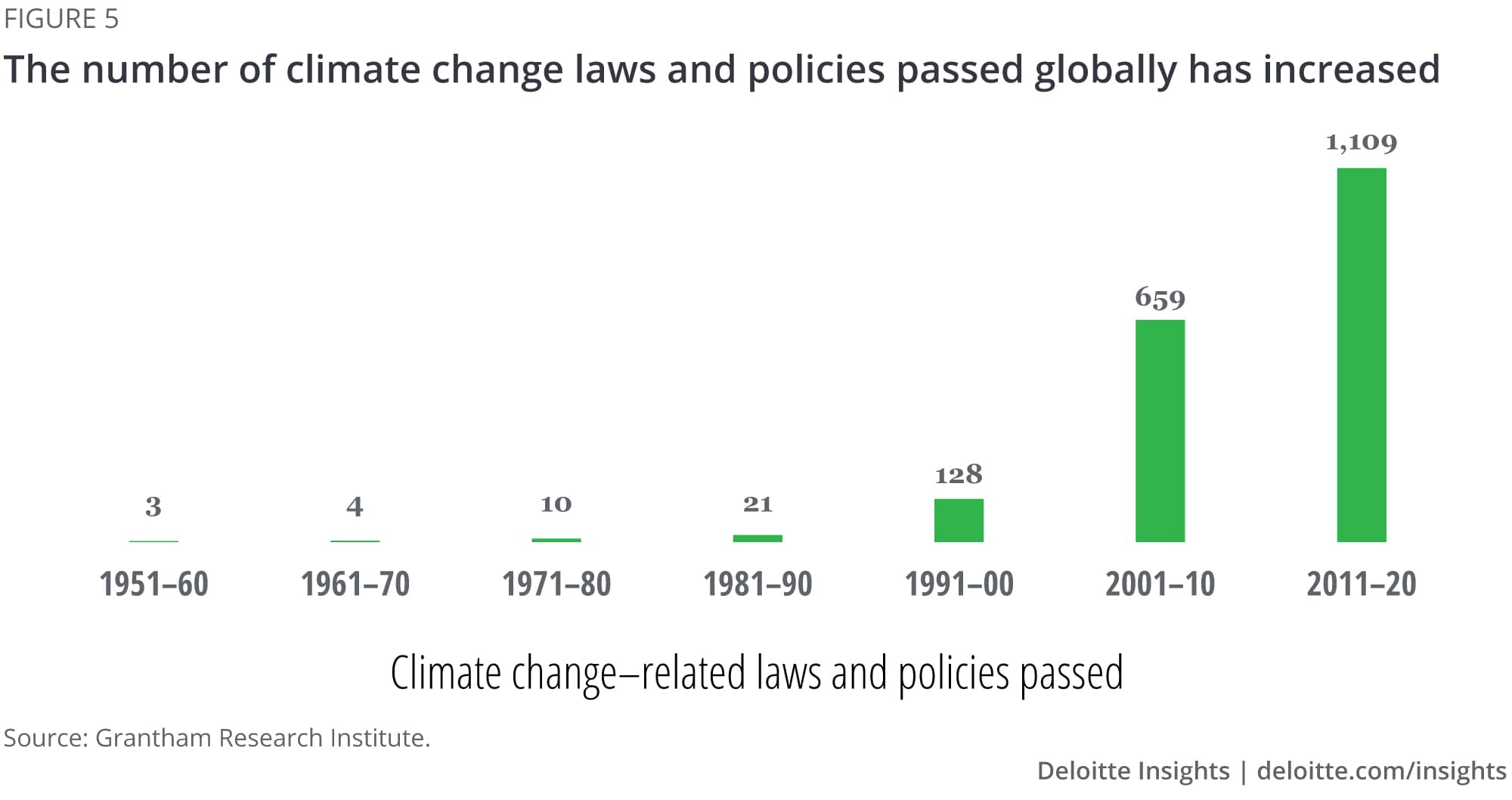
Climate Change 101 for business leaders Key questions and essential knowledge
9 minute read
06 January 2021
With climate change increasingly becoming a matter of concern for employees and environmentalists alike, companies can no longer ignore the issue. This primer serves as an FAQ for decision-makers to take stock of the climate change situation and make the right business decisions around it.
Introduction
Addressing climate change has moved steadily higher on the corporate agenda. Even as more of the business community acknowledges the fundamentals—that the emission of greenhouse gases by humans is changing the climate in ways that are harmful to the planet and human societies—many also struggle to go beyond those basics. How harmful, exactly? How quickly must we act, and at what scale?
This primer aims to equip busy leaders with climate change knowledge so they can ask the right questions, prioritize the right areas, and make the right decisions.
Learn more
Explore the Climate & sustainability collection
Learn about Deloitte's services
Go straight to smart. Get the Deloitte Insights app
Addressing climate change:
- starts with the basics of climate science;
- determines the potential impacts on the natural world and human societies;
- examines the potential risks of a changed climate to businesses in different sectors;
- assesses various stakeholders’ pressures and responds; and gets started with a plan.
If you’re already well on your way to addressing climate change in your own organization, great! We hope this primer helps you discover new, factual information that you’ll find useful. If you haven’t started to address your carbon emissions yet, this primer serves as your FAQ guide to go from awareness to action.
What is climate change and why is it happening?
Human GHG emissions are the dominant cause of climate change since the industrial age.
The overwhelming consensus of the scientific community is that human activities are the leading cause of the Earth’s warming in recent decades.1
Human actions, primarily burning fossil fuels but also deforestation and other activities, have resulted in a rapid increase in the concentration of greenhouse gases (GHG) in the atmosphere. GHGs, including carbon dioxide, methane, and nitrous oxide, trap heat close to the surface and cause global temperatures to rise. Since the industrial revolution, carbon dioxide concentrations have risen by more than 30%—currently 414 parts per million (ppm), up from 180–300 ppm historically (pre-industrial era).2 The result has been a global temperature increase of approximately 0.2 C per decade; today, mean surface temperatures are approximately 1.0 C (1.8 F) warmer than the pre-industrial period.3

How sure are scientists about climate change?
The scientific consensus on climate change is near-unanimous. Where predictions have been incorrect, it has typically been by underestimating the speed and severity of climate change.
The scientific consensus on climate change is robust.
Research indicates that roughly 98% of scientists endorse the conclusion of anthropogenic global warming: that the Earth’s climate is warming and human activity is the principal cause.4
Modeling the climate is highly complex, requiring an understanding of the interactions and feedback processes likely to occur across a wide range of Earth systems. Adding to the challenge, to the best of our knowledge, never before in the Earth’s history have carbon dioxide increases and attendant warming occurred as quickly as what we are experiencing today; we are truly in uncharted waters. Nevertheless, scientists’ climate models have been remarkably accurate at predicting global temperature rise5 (figure 2). Beyond temperature changes, scientists’ estimates have more often underestimated the speed and severity of the impacts of a changing climate (e.g., the melting of ice sheets).6 A range of climate tipping points that would create abrupt and irreversible changes—from the rapid collapse of ice sheets to permafrost thawing to the disruption of critical ocean currents—once thought to be extremely unlikely or only possible with a much warmer planet are now seen by many scientists as “too risky to bet against.”7

Is it a big deal if temperatures are a few degrees warmer?
Even moderate changes to the climate are likely to have dramatic and damaging consequences that are almost certain to affect every corner of the globe.
We are already experiencing the effects.
Climate change is already affecting many of the Earth’s natural systems. The frequency and severity of natural disasters—floods, hurricanes, fires, droughts, and more—are increasing and can be directly linked to this global phenomenon.8 Climate change is already happening. It also contributes to desertification, sea-level rise, ocean acidification, reduced air quality, rain pattern shifts, and loss of biodiversity. All of these changes can impact economies and human society in profound ways. Climate change is already a factor in more than 150,000 deaths annually across the globe,9 and it could create 143 million migrants by 2050.10 From 1980 to 2019, there was a fivefold increase in billion-dollar weather events in the United States.11
- Warmer, higher oceans and threats to cities: The oceans absorb excess carbon dioxide. Rising carbon dioxide concentrations lead to ocean acidification,12 which itself leads to the loss of ocean biodiversity. Higher surface water temperatures—which hit a record in 2019—result in oceans and other water bodies absorbing excess carbon dioxide.13 The thermal expansion of seawater erodes ice sheets and glaciers, contributing to further sea rise. Global sea levels rose about 8 inches in the last century. Predictions include a 0.46m rise in sea levels by 2100 (relative to 1986–2005 at 2 C warming).14 Rising seas put low-lying areas at risk and are a serious threat to cities and urban centers around the globe. Increased flooding seems guaranteed. Some cases may even result in environmental reclamation and total loss. Close to 150 million people across approximately 60,000 square kilometers of land area, and at least 136 megacities across the globe (such as New York City, Miami, Jakarta, and Mumbai) are at risk due to sea-level rise (at 2 C warming).15 The global economic costs just to cities from rising seas and flooding are predicted to amount to US$1 trillion over the next 30 years.16
- Impact on the poor and vulnerable: Climate change is likely to disproportionately affect disadvantaged and vulnerable populations through food and water insecurity, higher food prices, income losses, lost livelihood opportunities, adverse health impacts, and population displacements.17 At 2 C warming, nearly 600 million people would be exposed and vulnerable to water stress.18 Climate change is expected to be a poverty multiplier19 that makes poor people poorer and pushes more people into poverty. One-third of the population considered most vulnerable to the adverse effects of climate change comes from the world’s least-developed countries, which lack important infrastructure.20
- Biodiversity and feeding the planet: Biodiversity is declining globally at rates unprecedented in human history due to climate change and human activities.21 That in turn contributes to a compromised global food supply, which has the potential to threaten the well-being of at least 3.2 billion people around the world by 2050.22 Hotter temperatures can reduce crop yields23; for each degree-Celsius increase in global mean temperature yields of wheat can fall by up to 6.0%; rice by up to 3.2%; maize by up to 7.4%; and soybeans by up to 3.1%.24 Climate change is likely to make it increasingly challenging to feed a human population expected to grow to nearly 10 billion people by 2050.25
One-third of the population considered most vulnerable to the adverse effects of climate change comes from the world’s least-developed countries, which lack important infrastructure.
How will a changing climate impact business?
Climate change presents a range of risks for businesses across industries, from disrupted supply chains and higher insurance costs to labor challenges.
Companies’ work, workforces, and workplaces could all be impacted.
Work: What businesses do26
- Climate change is expected to have severe effects on business output. In the United States, studies estimate a 1.2% decline in the annual gross domestic product (GDP) for every 1 C increase in temperature.27
- Looking at a global scale, failure to limit temperature rise to 1.5 C may result in a reduction of the world’s real GDP per capita by roughly 7% by 2100. Limiting the increase to 1.5 C—in line with the Paris Agreement—or less could reduce GDP loss substantially to just over 1% per capita.28 Research shows that the GDP of countries closer to the equator will likely be more substantially impacted than those nearer to the poles.29
- Climate change and extreme weather—droughts, floods, storms—directly impact 70% of all economic sectors worldwide routinely.30 Sea level rise of <0.5m before 2100 would nearly double the number of current refineries exposed to flooding with a category 1 hurricane.31
Workforces: Who does the work
- By 2100, over 1 billion people are expected to be exposed and vulnerable to heatwaves at 1.5 C warming.32 Exposure and risks would be higher for outdoor workers.33
- Each 1 C increase could also reduce work productivity by 1–3% for people working outdoors or without air conditioning.34 Worker safety is also threatened by many factors including temperature extremes, air quality, water access and sanitation, and disease exposure.35 Heat stress resulting from global warming is projected to cause productivity losses equal to 80 million full-time jobs globally, translating to global economic losses of US$2.4 trillion by 2030 (at 1.5 C warming).36
- Between 2008 and 2016, close to 25 million people a year have been forcibly displaced by extreme weather conditions such as floods, storms, wildfires, and hotter temperatures,37 potentially causing workforce shortages in some regions and unemployment in others. The changing climate is predicted to directly result in 143 million additional climate migrants by 2050.38
Worker safety is threatened by many factors including temperature extremes, air quality, water access and sanitation, and disease exposure.
Workplaces: Where work gets done
- At least 80 airports around the world could be underwater if sea levels rise one meter (39 inches).39
- At least 136 port cities with populations greater than 1 million people could be at risk for flooding.40
- Climate risk may also disrupt the commercial and private real estate markets, particularly in vulnerable regions where it is possible that mortgages could default en masse or the demand for commercial real estate in threatened areas could disappear over time. 41
What do we need to do to mitigate climate change? And how soon?
The best available science indicates the world should cut GHG emissions in half by 2030 and reach net-zero by 2050 to help avert catastrophic warming.
The Intergovernmental Panel on Climate Change (IPCC), the most authoritative scientific body on the topic, finds that keeping mean surface temperature increases to no more than 1.5 C is critical for avoiding the most devastating impacts of climate change.
Doing so means cutting global GHG emissions by roughly 50% by 2030 (from 2010 levels) and reaching “net-zero” emissions—releasing no more carbon into the atmosphere than is removed—by 2050 (figure 3).42
Achieving net-zero carbon emission by 2050 would require a radical, top-to-bottom transformation of the global economic system, especially our energy, transportation, and agriculture practices.

What’s the difference between 1.5 C and 2.0 C?
The best-case scenario is that we limit warming to 1.5 C; an increase to 2.0 C or beyond is likely.
Half of a degree Celsius difference in global warming may sound insignificant. However, the effects at 2 C are significantly greater than at 1.5 C (figure 4).43 The relationship between warming and impact is not linear, and even seemingly small increases in absolute average temperature matter. The consequences almost certainly get worse and compound as the temperature ticks up.44
The relationship between warming and impact is not linear, and even seemingly small increases in absolute average temperature matter.

How much do stakeholders care about climate change?
More business constituencies are demanding action on climate change.
Important business stakeholders are increasingly prioritizing climate change—and pressing companies to do the same. Businesses’ societal license to operate is becoming contingent on their being good climate stewards.
Consumers:
- According to a recent European survey, more than nine in 10 citizens (94%) say that protecting the environment is important to them personally.45
- Roughly 40% of surveyed millennials say they would start, stop, or deepen/lessen a relationship with a brand based on a company’s impact on the environment, according to Deloitte’s 2019 Millennial Study.46
Employees:
- Roughly 80% of executives in a 2020 Deloitte survey indicated their employees were very concerned about climate change.47
- Forty-five percent of surveyed millennial employees in another study would look to change jobs if their company didn't implement sustainable business practices, and 44% would leave negative reviews for their company if they had poor sustainable business practices.48
- Thirty percent of US employees from large organizations (>5,000 employees) in another survey said that they had left a job because of the company’s lack of a sustainability plan.49
Investors and shareholders:
- Two-thirds of European CFOs surveyed reported feeling pressure from shareholders and investors to act on climate change.50 Fifty-seven percent of executives said their organization is facing significant pressure from investors to report on climate-related risk and management.51 As of November 2020 more than 500 investors globally, who collectively manage more than US$47 trillion in assets, have signed the Climate Action 100+ initiative that aims to ensure large corporate GHG emitters take action on climate.52
Governments and regulators:
- Governments across the world have dramatically increased climate-related policy and regulatory actions. Over the last three decades, there has been an almost tenfold rise in the number of laws and policies passed globally (figure 5).53 Morocco has one of the most ambitious plans to reduce its national emissions with the country’s National Energy Strategy calling for 52% of electricity production to come from renewable sources by 2030.54
- Many citizens believe that governments are still not doing enough to tackle the climate change problem. Two-thirds of surveyed US adults say the federal government is doing too little to reduce the effects of global climate change55 and 57% of global respondents say they would be put off from voting for a political party whose policies do not take climate change seriously.56

What can businesses do to mitigate and adapt to climate change?
Averting catastrophic levels of planetary warming presents leaders with an obligation and an opportunity.
Many organizations have already set out on this journey, but those who haven’t should:
Understand
- Develop a holistic understanding of the company’s climate impact, risks, and opportunities. Set goals.
- Create a comprehensive, science-based plan to mitigate emissions and manage risks. That likely will require working beyond the boundaries of your organization, with others across the industry, or with entirely new ecosystems of players. It also means deploying new management mindsets that shift priorities, constraints, and objectives for the business.57
Decarbonize
- Infuse awareness of and responsiveness to climate impacts into every key decision and every part of the business. Inject climate management strategy into company priorities.
- Deploy emission reduction strategies and prioritize decarbonization options for both direct operations and value chain.
Integrate
- Go beyond defensive moves. Explore and identify new business models to create value. Develop partnerships.
- Integrate climate into business function decisions and transformations. Establish governance mechanisms to build climate into roles, responsibilities, remuneration, and accountability.
For more details on how companies can embark on their journey to become climate stewards, see Deloitte’s research at: https://www2.deloitte.com/us/en/insights/focus/climate-and-sustainability.html.
© 2021. See Terms of Use for more information.
Explore more articles on Sustainability
-
Energy management: Paused by pandemic, but poised to prevail Article4 years ago
-
Marine plastic pollution Article4 years ago
-
Looking beyond the horizon Article4 years ago
-
The journey of resilient leadership Article4 years ago
-
Embedding trust into COVID-19 recovery Article4 years ago
-
Advancing environmental, social, and governance investing Article4 years ago




















